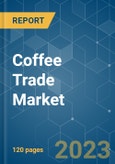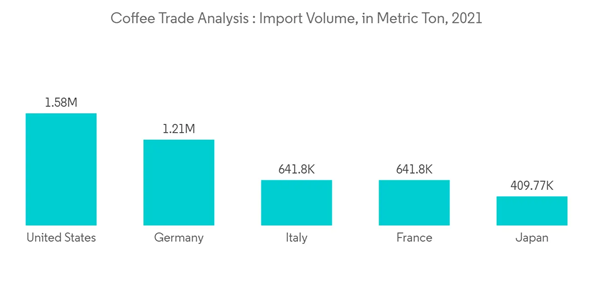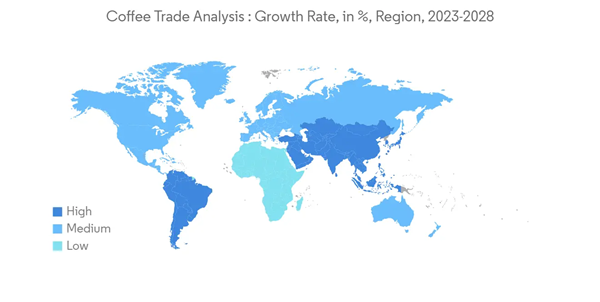Key Highlights
- Coffee is produced in more than 50 developing countries in South America, Africa, and Asia and is an essential source of income for more than 20-25 million families worldwide. The initial production of coffee beans is highly labor intensive. It involves several labor-intensive activities, such as farming, collecting, and processing. Hence, these activities are performed in labor-abundant countries.
- According to the United States Department of Agriculture (USDA), world coffee production for 2022-23 is forecast to rebound 6.6 million bags from the previous year to 172.8 million, primarily due to Brazil’s Arabica crop entering the on-year of the biennial production cycle. Global consumption is expected to rise by 800,000 bags to 167.9 million, with the largest gains in the European Union, the United States, and Brazil. World coffee bean exports are forecasted to be 3.0 million bags lower than 116.1 million as losses in Brazil, Vietnam, and India are more than offset gains in Honduras and Colombia in 2023. Ending stocks expected 1.5 million bags higher to 34.1 million. Against this backdrop of an improving supply situation, coffee prices, as measured by the International Coffee Organization (ICO) monthly composite price index, declined by 25% since February 2022.
- Additionally, the coffee industry witnesses various issues from farms to markets, like poor labor practices combined with unfair wages, deforestation, air pollution from roasting plants, and irregular pricing of coffee. According to a survey conducted by the Institute for Scientific Information on Coffee (ISIC) in 2020, 68% of the respondents stated that they often consume coffee while working. This trend is leading to a huge demand for coffee in European countries like Germany, Italy, Spain, the United Kingdom, and others, as consumers are becoming increasingly conscious of the quality of their coffee.
Coffee Trade Market Trends
United States Dominates the Global Imports
- Coffee provides a revitalizing effect as it contains caffeine. It is one of the most consumed and popular drinks worldwide. It is prepared and presented in different ways. As per some clinical studies, modest coffee consumption is gentle or slightly beneficial for healthy adults.
- The shifting work culture, specifically in the corporate industry, along with enhancing living standards, is further anticipated to boost the demand in the global market. Over the years, the coffee demand has significantly broadened beyond mature markets such as the European Union (EU), the United States, and Japan.
- According to the International Trade Center (ITC) Trademap, the United States accounted for 1,580,333 metric tons of coffee beans in 2021. Colombia, Brazil, Switzerland, Canada, and Guatemala are some of the major exporters of coffee in the United States, estimated at 20.1%, 18.4%, 11.6%, 6.4%, and 6.1%, respectively.
- Companies changing their service and establishing modern brand strategies to increase consumer satisfaction and build loyalty are other factors in improving the coffee market worldwide. This is supported by the emergence of various cafes and increased expendable income levels of consumers. All these factors are anticipated to bolster the market growth.
- Green coffee is becoming increasingly popular as consumer purchasing habits change in favor of healthier product options, improving general physical wellness and raising awareness of the prevalence of lifestyle-related health conditions like obesity, cardiovascular disease, and diabetes. For instance, in September 2022, the Green Coffee Company (GCC) launched its USD 100m Series C funding round to grow its Colombian operations and build a US-based coffee roasting operation to expand its value chain.
Brazil Dominates the Global Coffee Exports
- Brazil produces around 25% of the world's coffee supply. Coffee grown in Brazil is predominantly of the Arabica variety, making up around 80% of the total crop. Harvest season runs from May to August. The global demand for coffee heavily contributed to the early phase of Brazil's modern economic expansion and industrialization.
- According to the International Coffee Organization (ICO), Brazil is the major producer and exporter of coffee in the global market. According to the Council of Coffee Exporters of Brazil (Cecafé), the main destination markets for Brazil's coffee exports have been the United States, Germany, Belgium, Italy, Japan, Turkey, Russia, Mexico, Spain, and Canada.
- As per the United States Department of Agriculture (USDA) report 2022, Brazil's Arabica output rebounded from 3.4 million bags to 39.8 million. The majority of the producing areas are in the on-year of the biennial production cycle, resulting in higher production potential for the upcoming crop; however, this quantity is well below recent on-year crops that peaked at nearly 50 million bags.
- According to the International Trade Center (ITC) Trademap, in 2022, the major importers of coffee from Brazil were the United States accounting for 446,472 metric tons, Germany with 404,068 metric tons, Belgium with 175,582 metric tons, Italy with 174,451 metric tons, and Japan with 149,402 metric tons. Brazil currently exports the majority of its coffee to Germany and the United States. The United States is the world's largest single buyer of coffee, with the North American coffee market accounting for over one-quarter of the global coffee imports in value. The coffee trade helps Brazil remain one of the ten major trading partners of the United States.
Additional Benefits:
- The market estimate (ME) sheet in Excel format
- 3 months of analyst support
This product will be delivered within 2 business days.










